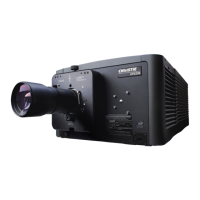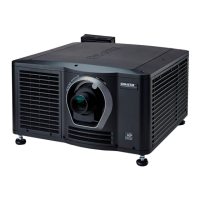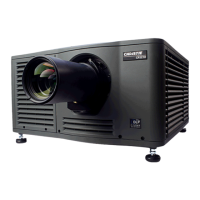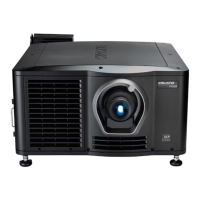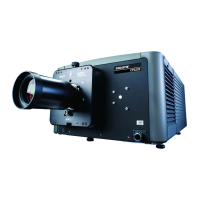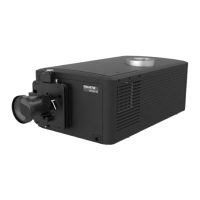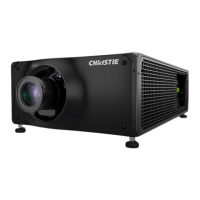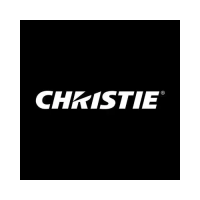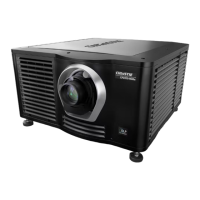




Do you have a question about the Christie CP2220 and is the answer not in the manual?
Legal notice about ownership and usage rights of brands and product names.
Compliance details for FCC rules and Canadian ICES-003 standards.
Covers general product information, disclaimers, and warranty policies.
Importance of maintenance for product operation and warranty validity.
Explains warning labels and symbols used on the projector for safety.
Essential safety measures to prevent eye damage and fire hazards.
Critical safety instructions for electrical connections and power supply.
Safety guidelines for handling high-pressure lamps to prevent explosion hazards.
Information for contacting dealers for service and support, including record-keeping tables.
Specifies environmental and power conditions necessary for projector installation.
Lists necessary tools and safety equipment for installing the projector.
Identifies and describes key physical components of the projector.
Detailed descriptions of projector parts like lamp door, LED indicators, and input panel connections.
Explains the ICP board LEDs and faceplate connection functions.
Highlights critical safety warnings for qualified technicians during installation.
Guidance on ideal placement and orientation of the projector relative to the screen.
Instructions for adjusting projector feet to achieve proper tilt and leveling.
Step-by-step guide for mounting and connecting the TPC.
Details on connecting the exhaust system and airflow requirements.
Procedure to measure and calculate required airflow for projector cooling.
Steps for installing the main projection lens and initial calibration.
Procedure for mounting and aligning an optional anamorphic lens.
Steps for installing an optional wide converter lens.
Safety and procedure for installing a new projector lamp.
Instructions for permanent electrical hookup, including wiring and breaker requirements.
Further details on routing power cables and connecting to the terminal block.
Instructions for connecting AC power via a pluggable Type B connection.
Steps to connect the projector to an optional UPS for power continuity.
Procedures for connecting input devices and powering on the projector for the first time.
Guidance on connecting cinema servers and other sources via HD-SDI and Ethernet.
Instructions for connecting standard PC sources via DVI ports.
Details on establishing network and serial communications with the projector.
Explains the Simple Contact Closure Interface (SCCI) port for basic control functions.
Details on configuring and using the General Purpose Input/Output (GPIO) port for external devices.
Provides a circuit diagram for custom GPIO cable applications.
Pinout and function details for the 3D connector.
Procedure to optimize lamp position for peak brightness and performance.
Steps to calibrate screen brightness using the Foot Lamberts wizard.
Ensures image is parallel and centered with the lens and screen before boresight.
How to adjust horizontal and vertical offset for optimal image centering.
Using the Intelligent Lens System (ILS) for offset adjustments.
Balancing lens mount tilt and maintaining axial position for boresight.
Detailed steps for adjusting horizontal boresight for focus and alignment.
Steps for focusing the top/bottom edges and balancing the image.
Performing top and bottom boresight adjustments using the ILS.
Safety and procedure for adjusting red, green, and blue micromirror alignment.
How to adjust the fold mirror to correct missing image corners or edges.
Covers system calibration, color calibration, and electronic screen masking.
Introduction to setting up and managing 3D content.
Lists necessary hardware and software for 3D display.
Overview of hardware configurations for various 3D systems.
Steps to install and configure a 3D server with a YCxCz interface.
Customizing 3D lamp files for specific hardware requirements.
Procedure to create measured color gamut data files for 3D accuracy.
Settings for the 3D Flat 1998x1080 channel configuration.
Settings for the 3D Scope 2048x858 channel configuration.
Using test patterns to verify 3D hardware functionality.
Explains how to use and interpret various 3D test patterns.
Details on the RGB-12bit-3D Four Quadrant test pattern.
Explains the Half Descending and L-Test patterns for 3D diagnostics.
Steps to verify correct left/right eye display and troubleshoot reversed images.
Solutions for common 3D issues like image breakup and darkness.
Addresses ghosting, motion artifacts, and flashing in 3D presentations.
Procedure for powering on the projector and igniting the lamp.
Steps for safely powering down the projector, including cool-down.
Table explaining projector states based on TPC button presses.
Explains the meaning of the projector's status LEDs (red, yellow, green).
Covers adjusting lamp power, percentages, and using LampLOC for position.
Detailed steps for manual adjustment of lamp position using directional arrows.
Accessing lamp history and setting up expiry/rotation alarms.
Lists lamp expiry hours and minimum/maximum power ratings.
Overview of lens mount functionality and the Intelligent Lens System (ILS).
Covers accessing, enabling, altering, maintaining, and resetting ILS settings.
Procedure for calibrating the ILS when a new lens is installed.
Guidance on presenting movies and connecting various digital media sources.
Explains how to use anamorphic and wide converter lenses for image format adjustments.
Explains top and side masking for concealing unused screen edges.
How to connect and display content from non-cinema sources via DVI.
How to choose input sources using pre-configured projector channels.
Introduction to the TPC for controlling projector settings and viewing status.
Explains the layout and controls of the TPC Main screen.
Details the functions of the TPC Main screen controls like Power, Lamp, and Test Patterns.
How to open and use the on-screen keyboard for numerical input.
Defines user levels (Operator, Admin) and their access rights to projector functions.
How to access and interpret the Status window for projector item status.
Explains the status indicators (LEDs) and how to adjust column widths.
Lists status items for cooling, temperatures, interlocks, signal, and health.
Continues listing status details for configuration, peripherals, and system components.
Lists status items for security, serial numbers, and component versions.
How to view, acknowledge, and clear projector alarms.
Accessing and using the Interrogator for log files and configuration data.
Explains Basic and Enhanced modes for interrogator function.
Displays HD-SDI signal integrity and error counts.
How to retrieve and download system log files.
Managing DLP hardware, certificates, and self-tests.
Accessing and interacting with network devices like Christie ACT.
Creating and storing custom projector settings for different inputs.
Configuring channel settings like input, data format, and source files.
Adjusting color settings, gamma, and scan types within a channel.
Adjusting and synchronizing 3D signals with external equipment.
Explains 3D sync modes, polarity, dark time, and output delay.
Illustrates frame rate multiples for 3D synchronization.
Introduction to advanced settings for lamp and lens parameters.
Configuring lamp power and LiteLOC settings for brightness maintenance.
Details on Power %, LiteLOC enable, and light meter readings.
Viewing previous lamp installations and acknowledging rotations.
Procedure for adding new lamp details to the history.
Using LampLOC to optimize lamp position for light output.
Explains progress bar, auto adjustment, and cancellation of LampLOC.
Modifying Intelligent Lens System settings and performing manual adjustments.
Setting up primary/auxiliary lenses and configuring the Intelligent Lens System.
Creating files for resolution, offset, and aspect ratio settings for inputs.
Defining display panel size and image cropping settings.
Correcting on-screen colors using Measured Color Gamut Data files.
Modifying or creating Target Color Gamut Data files for display.
Accessing projector settings requiring Administrator permissions.
Accessing Windows OS functions on the projector's TPC.
Organizing and managing channels displayed on the TPC Main panel.
Managing and organizing preferred test patterns for display.
Modifying system settings like temperature units and language.
Indicating installation status of Link Decryptor (LD) or Image Media Block (IMB).
Setting projector time zone, date, and daylight savings.
Scheduling projector power on/off times.
Creating and editing scheduled power events.
Configuring Ethernet, serial, SNMP, and remote access settings.
Viewing and setting up network parameters for external devices.
Configuring GPIO interface inputs and outputs for external devices.
Calibrating the internal light meter to measure Foot Lamberts.
Managing users, passwords, and access rights on the TPC.
Steps to add a new user with specified permissions.
Selecting upgrade files for projector software installation.
Reviewing package details and choosing upgrade components or installation type.
Accessing service functions for managing backups and restores.
Managing backups, restores, and factory defaults.
Engaging marriage for secure content playback and DCI activation.
Accessing Windows Task Manager, Computer Management, etc.
Enabling or disabling monitoring for optional card cage fans.
Electronically adjusting red, green, and blue micromirror alignment.
Activating Image Media Block (IMB) marriage for secure content.
Viewing projector serial number, software version, and component details.
Accessing help information related to the Touch Panel Controller windows.
Ensuring proper airflow by checking vents and maintaining clearances.
Safety and procedure for checking and topping up the liquid cooling system.
Checking lamp connections for cleanliness and security.
Guidelines for cleaning the lens and lamp reflector without degrading surfaces.
Steps for removing dust and smudges from the projector lens.
Inspecting and cleaning the lamp reflector surface.
Procedures for inspecting and cleaning the lamp blower impeller.
Detailed safety and procedural steps for lamp replacement.
Steps for removing the old lamp and inspecting the reflector.
Step-by-step instructions for installing a new lamp.
Procedure for rotating the lamp to ensure even burn and extend life.
Instructions for replacing the light engine air filter for projector cooling.
Instructions for replacing the liquid cooling system's air filter.
Procedure for replacing the primary lens and calibrating it.
Steps to diagnose and resolve issues when the projector fails to power on.
Troubleshooting steps for when the projector lamp does not ignite.
Diagnosing and resolving issues with the lamp shutting off unexpectedly.
Troubleshooting common image quality issues like flicker and dimness.
Troubleshooting problems with LampLOC™ and LiteLOC™ functionality.
Resolving problems with the TPC display or responsiveness.
Troubleshooting network and IP address conflicts for communication.
Diagnosing issues causing a blank screen or no image display.
Addressing motion artifacts related to synchronization or conversion.
Resolving issues with image aspect ratio distortion.
Troubleshooting problems with encrypted content decoding or tamper warnings.
Adjusting color settings to resolve color inaccuracies.
Fixing rectangularity issues by checking leveling and lens settings.
Troubleshooting noisy images by checking input source and cable requirements.
Procedure to resolve a frozen display by power cycling the projector.
Adjusting settings or using an anamorphic lens to fix cropped image data.
Diagnosing why there is no display when the projector is on.
Troubleshooting display instability due to input device or sync signals.
Resolving faint display issues by checking source termination and sync tip clamp.
Adjusting resizing settings or using anamorphic lens for image cropping.
Correcting vertical stretching by adjusting pixel sampling clock and settings.
Troubleshooting inconsistent picture quality by verifying signal and frequencies.
Details panel resolution, refresh rate, brightness, contrast, color, and white point.
Lists supported SMPTE 292M formats for cinema sources.
Lists additional supported signal formats, including DCI.
Specifies supported formats for DVI-D ports, single and twin-link.
Details compatibility for Ethernet, RS232, GPIO, and SCCI ports.
Technical specifications for TPC-660E model.
Technical specifications for TPC-650H model.
Specifies voltage, current, and power consumption for AC and UPS inputs.
Details lamp types, average life, warm-up, and other parameters.
Provides dimensions, weight, and operating position details.
Lists safety and electromagnetic compatibility regulations the product conforms to.
Specifies operating and non-operating temperature and humidity ranges.
Lists standard accessories and optional lenses sold separately.
Lists various optional zoom lenses, mounts, and kits.
Lists part numbers for replacement lamps, filters, and cables.
Serial commands for controlling motorized auxiliary lenses.
Serial commands to control automatic scan type detection.
Serial commands for setting baud rate and selecting channels.
Commands for setting channel icons and color spaces.
Commands for resetting defaults and managing engineering log data.
Commands for selecting data formats and enabling error messages.
Serial commands for adjusting lens focus position.
Commands for setting gamma response curves for source signals.
Retrieving lamp history and getting help on serial commands.
Commands for managing ICP files (LUTs, MCGD, TCGD, etc.).
Commands for ICP file management and setting ILS files.
Commands to enable/disable and calibrate the Intelligent Lens System.
Further ILS commands and commands for managing Internal Media Block (IMB).
Commands to start and check interrogator status.
Listing and selecting internal test patterns.
Commands for calibrating lamp intensity to footlamberts.
Commands to set Look Up Table (LUT) Color Look Up Table (CLUT) files.
Commands for bypassing link decryptor and setting LD installed status.
Defining model and serial number for lenses.
Adjusting lens offset to specific horizontal positions.
Retrieving lamp hours and setting lamp intensity.
Setting/getting expected lamp life and managing expiry warnings.
Setting lamp mode and power for channels.
Adjusting lens offset to specific vertical positions.
Selecting Measured Color Gamut files for color processing.
Managing MCGD values and monitoring card cage fans.
Setting channel names and network parameters (IP, Gateway).
Setting network parameters and projector configuration files.
Selecting whether to use the PCF file or not.
Retrieving projector info and changing power states.
Setting remote serial protocol access levels.
Commands for rebooting the TPC and scheduling power events.
Selecting screen format files for output geometry.
Commands to control the shutter/douser and select input ports.
Configuring SNMP agent options.
SNMP configuration and setting screen orientation.
Selecting source formats and retrieving system status.
Commands for retrieving cooling, health, interlock, lamp, and peripheral data.
Stopping DLP communication and querying platform version info.
Setting Target Color Gamut files for projector colorimetry.
Enabling 3D and setting dark time for 3D control.
Setting frame rate multiples for 3D synchronization.
Retrieving LD or ICP certificates.
Setting the L/R display reference for 3D control.
Setting and getting time, date, and time zone.
Setting output timing signal reference polarity for 3D.
Logging users in and out of the serial interface.
Adjusting lens zoom position with specified directions.
Legal notice about ownership and usage rights of brands and product names.
Compliance details for FCC rules and Canadian ICES-003 standards.
Covers general product information, disclaimers, and warranty policies.
Importance of maintenance for product operation and warranty validity.
Explains warning labels and symbols used on the projector for safety.
Essential safety measures to prevent eye damage and fire hazards.
Critical safety instructions for electrical connections and power supply.
Safety guidelines for handling high-pressure lamps to prevent explosion hazards.
Information for contacting dealers for service and support, including record-keeping tables.
Specifies environmental and power conditions necessary for projector installation.
Lists necessary tools and safety equipment for installing the projector.
Identifies and describes key physical components of the projector.
Detailed descriptions of projector parts like lamp door, LED indicators, and input panel connections.
Explains the ICP board LEDs and faceplate connection functions.
Highlights critical safety warnings for qualified technicians during installation.
Guidance on ideal placement and orientation of the projector relative to the screen.
Instructions for adjusting projector feet to achieve proper tilt and leveling.
Step-by-step guide for mounting and connecting the TPC.
Details on connecting the exhaust system and airflow requirements.
Procedure to measure and calculate required airflow for projector cooling.
Steps for installing the main projection lens and initial calibration.
Procedure for mounting and aligning an optional anamorphic lens.
Steps for installing an optional wide converter lens.
Safety and procedure for installing a new projector lamp.
Instructions for permanent electrical hookup, including wiring and breaker requirements.
Further details on routing power cables and connecting to the terminal block.
Instructions for connecting AC power via a pluggable Type B connection.
Steps to connect the projector to an optional UPS for power continuity.
Procedures for connecting input devices and powering on the projector for the first time.
Guidance on connecting cinema servers and other sources via HD-SDI and Ethernet.
Instructions for connecting standard PC sources via DVI ports.
Details on establishing network and serial communications with the projector.
Explains the Simple Contact Closure Interface (SCCI) port for basic control functions.
Details on configuring and using the General Purpose Input/Output (GPIO) port for external devices.
Provides a circuit diagram for custom GPIO cable applications.
Pinout and function details for the 3D connector.
Procedure to optimize lamp position for peak brightness and performance.
Steps to calibrate screen brightness using the Foot Lamberts wizard.
Ensures image is parallel and centered with the lens and screen before boresight.
How to adjust horizontal and vertical offset for optimal image centering.
Using the Intelligent Lens System (ILS) for offset adjustments.
Balancing lens mount tilt and maintaining axial position for boresight.
Detailed steps for adjusting horizontal boresight for focus and alignment.
Steps for focusing the top/bottom edges and balancing the image.
Performing top and bottom boresight adjustments using the ILS.
Safety and procedure for adjusting red, green, and blue micromirror alignment.
How to adjust the fold mirror to correct missing image corners or edges.
Covers system calibration, color calibration, and electronic screen masking.
Introduction to setting up and managing 3D content.
Lists necessary hardware and software for 3D display.
Overview of hardware configurations for various 3D systems.
Steps to install and configure a 3D server with a YCxCz interface.
Customizing 3D lamp files for specific hardware requirements.
Procedure to create measured color gamut data files for 3D accuracy.
Settings for the 3D Flat 1998x1080 channel configuration.
Settings for the 3D Scope 2048x858 channel configuration.
Using test patterns to verify 3D hardware functionality.
Explains how to use and interpret various 3D test patterns.
Details on the RGB-12bit-3D Four Quadrant test pattern.
Explains the Half Descending and L-Test patterns for 3D diagnostics.
Steps to verify correct left/right eye display and troubleshoot reversed images.
Solutions for common 3D issues like image breakup and darkness.
Addresses ghosting, motion artifacts, and flashing in 3D presentations.
Procedure for powering on the projector and igniting the lamp.
Steps for safely powering down the projector, including cool-down.
Table explaining projector states based on TPC button presses.
Explains the meaning of the projector's status LEDs (red, yellow, green).
Covers adjusting lamp power, percentages, and using LampLOC for position.
Detailed steps for manual adjustment of lamp position using directional arrows.
Accessing lamp history and setting up expiry/rotation alarms.
Lists lamp expiry hours and minimum/maximum power ratings.
Overview of lens mount functionality and the Intelligent Lens System (ILS).
Covers accessing, enabling, altering, maintaining, and resetting ILS settings.
Procedure for calibrating the ILS when a new lens is installed.
Guidance on presenting movies and connecting various digital media sources.
Explains how to use anamorphic and wide converter lenses for image format adjustments.
Explains top and side masking for concealing unused screen edges.
How to connect and display content from non-cinema sources via DVI.
How to choose input sources using pre-configured projector channels.
Introduction to the TPC for controlling projector settings and viewing status.
Explains the layout and controls of the TPC Main screen.
Details the functions of the TPC Main screen controls like Power, Lamp, and Test Patterns.
How to open and use the on-screen keyboard for numerical input.
Defines user levels (Operator, Admin) and their access rights to projector functions.
How to access and interpret the Status window for projector item status.
Explains the status indicators (LEDs) and how to adjust column widths.
Lists status items for cooling, temperatures, interlocks, signal, and health.
Continues listing status details for configuration, peripherals, and system components.
Lists status items for security, serial numbers, and component versions.
How to view, acknowledge, and clear projector alarms.
Accessing and using the Interrogator for log files and configuration data.
Explains Basic and Enhanced modes for interrogator function.
Displays HD-SDI signal integrity and error counts.
How to retrieve and download system log files.
Managing DLP hardware, certificates, and self-tests.
Accessing and interacting with network devices like Christie ACT.
Creating and storing custom projector settings for different inputs.
Configuring channel settings like input, data format, and source files.
Adjusting color settings, gamma, and scan types within a channel.
Adjusting and synchronizing 3D signals with external equipment.
Explains 3D sync modes, polarity, dark time, and output delay.
Illustrates frame rate multiples for 3D synchronization.
Introduction to advanced settings for lamp and lens parameters.
Configuring lamp power and LiteLOC settings for brightness maintenance.
Details on Power %, LiteLOC enable, and light meter readings.
Viewing previous lamp installations and acknowledging rotations.
Procedure for adding new lamp details to the history.
Using LampLOC to optimize lamp position for light output.
Explains progress bar, auto adjustment, and cancellation of LampLOC.
Modifying Intelligent Lens System settings and performing manual adjustments.
Setting up primary/auxiliary lenses and configuring the Intelligent Lens System.
Creating files for resolution, offset, and aspect ratio settings for inputs.
Defining display panel size and image cropping settings.
Correcting on-screen colors using Measured Color Gamut Data files.
Modifying or creating Target Color Gamut Data files for display.
Accessing projector settings requiring Administrator permissions.
Accessing Windows OS functions on the projector's TPC.
Organizing and managing channels displayed on the TPC Main panel.
Managing and organizing preferred test patterns for display.
Modifying system settings like temperature units and language.
Indicating installation status of Link Decryptor (LD) or Image Media Block (IMB).
Setting projector time zone, date, and daylight savings.
Scheduling projector power on/off times.
Creating and editing scheduled power events.
Configuring Ethernet, serial, SNMP, and remote access settings.
Viewing and setting up network parameters for external devices.
Configuring GPIO interface inputs and outputs for external devices.
Calibrating the internal light meter to measure Foot Lamberts.
Managing users, passwords, and access rights on the TPC.
Steps to add a new user with specified permissions.
Selecting upgrade files for projector software installation.
Reviewing package details and choosing upgrade components or installation type.
Accessing service functions for managing backups and restores.
Managing backups, restores, and factory defaults.
Engaging marriage for secure content playback and DCI activation.
Accessing Windows Task Manager, Computer Management, etc.
Enabling or disabling monitoring for optional card cage fans.
Electronically adjusting red, green, and blue micromirror alignment.
Activating Image Media Block (IMB) marriage for secure content.
Viewing projector serial number, software version, and component details.
Accessing help information related to the Touch Panel Controller windows.
Ensuring proper airflow by checking vents and maintaining clearances.
Safety and procedure for checking and topping up the liquid cooling system.
Checking lamp connections for cleanliness and security.
Guidelines for cleaning the lens and lamp reflector without degrading surfaces.
Steps for removing dust and smudges from the projector lens.
Inspecting and cleaning the lamp reflector surface.
Procedures for inspecting and cleaning the lamp blower impeller.
Detailed safety and procedural steps for lamp replacement.
Steps for removing the old lamp and inspecting the reflector.
Step-by-step instructions for installing a new lamp.
Procedure for rotating the lamp to ensure even burn and extend life.
Instructions for replacing the light engine air filter for projector cooling.
Instructions for replacing the liquid cooling system's air filter.
Procedure for replacing the primary lens and calibrating it.
Steps to diagnose and resolve issues when the projector fails to power on.
Troubleshooting steps for when the projector lamp does not ignite.
Diagnosing and resolving issues with the lamp shutting off unexpectedly.
Troubleshooting common image quality issues like flicker and dimness.
Troubleshooting problems with LampLOC™ and LiteLOC™ functionality.
Resolving problems with the TPC display or responsiveness.
Troubleshooting network and IP address conflicts for communication.
Diagnosing issues causing a blank screen or no image display.
Addressing motion artifacts related to synchronization or conversion.
Resolving issues with image aspect ratio distortion.
Troubleshooting problems with encrypted content decoding or tamper warnings.
Adjusting color settings to resolve color inaccuracies.
Fixing rectangularity issues by checking leveling and lens settings.
Troubleshooting noisy images by checking input source and cable requirements.
Procedure to resolve a frozen display by power cycling the projector.
Adjusting settings or using an anamorphic lens to fix cropped image data.
Diagnosing why there is no display when the projector is on.
Troubleshooting display instability due to input device or sync signals.
Resolving faint display issues by checking source termination and sync tip clamp.
Adjusting resizing settings or using anamorphic lens for image cropping.
Correcting vertical stretching by adjusting pixel sampling clock and settings.
Troubleshooting inconsistent picture quality by verifying signal and frequencies.
Details panel resolution, refresh rate, brightness, contrast, color, and white point.
Lists supported SMPTE 292M formats for cinema sources.
Lists additional supported signal formats, including DCI.
Specifies supported formats for DVI-D ports, single and twin-link.
Details compatibility for Ethernet, RS232, GPIO, and SCCI ports.
Technical specifications for TPC-660E model.
Technical specifications for TPC-650H model.
Specifies voltage, current, and power consumption for AC and UPS inputs.
Details lamp types, average life, warm-up, and other parameters.
Provides dimensions, weight, and operating position details.
Lists safety and electromagnetic compatibility regulations the product conforms to.
Specifies operating and non-operating temperature and humidity ranges.
Lists standard accessories and optional lenses sold separately.
Lists various optional zoom lenses, mounts, and kits.
Lists part numbers for replacement lamps, filters, and cables.
Serial commands for controlling motorized auxiliary lenses.
Serial commands to control automatic scan type detection.
Serial commands for setting baud rate and selecting channels.
Commands for setting channel icons and color spaces.
Commands for resetting defaults and managing engineering log data.
Commands for selecting data formats and enabling error messages.
Serial commands for adjusting lens focus position.
Commands for setting gamma response curves for source signals.
Retrieving lamp history and getting help on serial commands.
Commands for managing ICP files (LUTs, MCGD, TCGD, etc.).
Commands for ICP file management and setting ILS files.
Commands to enable/disable and calibrate the Intelligent Lens System.
Further ILS commands and commands for managing Internal Media Block (IMB).
Commands to start and check interrogator status.
Listing and selecting internal test patterns.
Commands for calibrating lamp intensity to footlamberts.
Commands to set Look Up Table (LUT) Color Look Up Table (CLUT) files.
Commands for bypassing link decryptor and setting LD installed status.
Defining model and serial number for lenses.
Adjusting lens offset to specific horizontal positions.
Retrieving lamp hours and setting lamp intensity.
Setting/getting expected lamp life and managing expiry warnings.
Setting lamp mode and power for channels.
Adjusting lens offset to specific vertical positions.
Selecting Measured Color Gamut files for color processing.
Managing MCGD values and monitoring card cage fans.
Setting channel names and network parameters (IP, Gateway).
Setting network parameters and projector configuration files.
Selecting whether to use the PCF file or not.
Retrieving projector info and changing power states.
Setting remote serial protocol access levels.
Commands for rebooting the TPC and scheduling power events.
Selecting screen format files for output geometry.
Commands to control the shutter/douser and select input ports.
Configuring SNMP agent options.
SNMP configuration and setting screen orientation.
Selecting source formats and retrieving system status.
Commands for retrieving cooling, health, interlock, lamp, and peripheral data.
Stopping DLP communication and querying platform version info.
Setting Target Color Gamut files for projector colorimetry.
Enabling 3D and setting dark time for 3D control.
Setting frame rate multiples for 3D synchronization.
Retrieving LD or ICP certificates.
Setting the L/R display reference for 3D control.
Setting and getting time, date, and time zone.
Setting output timing signal reference polarity for 3D.
Logging users in and out of the serial interface.
Adjusting lens zoom position with specified directions.
